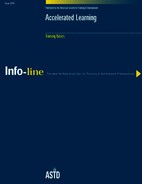Accelerated Learning Principles
The purpose of accelerated learning is to involve both the right and left hemispheres and the cortex and limbic systems of the brain in learning. By involving the different functions, learning is made more natural. Several principles are involved in accelerated learning, and these include:
Affective State
The brain chemistry of a positive state of the nervous system differs from that of a fearful and angry state. Stressful environments cause the brain to “downshift” naturally. Eliminating excess stress, fear of failure, and negativity greatly enhances the learner's receptivity to training.
Beliefs Toward Learning
Many people believe that learning is difficult—a belief that can be altered. Learning is one of the most joyful and natural aspects of being human. Unfortunately, many of us have a diminished view of our intelligence, learning abilities, and performance potential. Many people underachieve not because of a lack of intelligence but because of an insufficient belief in their ability or power to learn or to accomplish some task. Henry Ford put it succinctly: “Whether you believe you can or you believe you can't, you're right.” We now have techniques for helping learners govern their beliefs and attitudes.
Information Networks
Information is recorded in vast interconnecting neural networks. Provisions for connecting new material to content learned previously and applying new material back on the job increase the integration and retention of learning. A global context for the learning material makes learning easier.
Nonconscious Learning
As much as 80 percent of learning may be nonconscious. Accelerative learning techniques work with more of the mind, maximizing our natural potential for learning.
Learning Cycles
A learner's attention cycles require restimulation of an optimal learning state through changes of pace. Shorter segments are better processed and retained than longer, continuous learning segments.
Multisensory Input
Learners have different learning styles: Individuals have many different ways of processing information and experiences through the visual, auditory, and kinesthetic senses. Providing multisensory instruction enhances information processing through greater stimulation and provides reinforcement through other channels.
Learning Readiness State
A calm, relaxed state—physically and mentally—is the optimum state for peak learning. In a relaxed state, the brain produces steady alpha rhythms, one of four types of brain waves. The types of brain waves correspond to different mental states. Alpha waves characterize a calm but alert state conducive to rapid assimilation of information. In the alpha state, learning happens effortlessly.
In practice, these principles interconnect so that the training orchestrates learning in a holistic manner. The next section describes techniques for intentionally linking and applying these principles.
